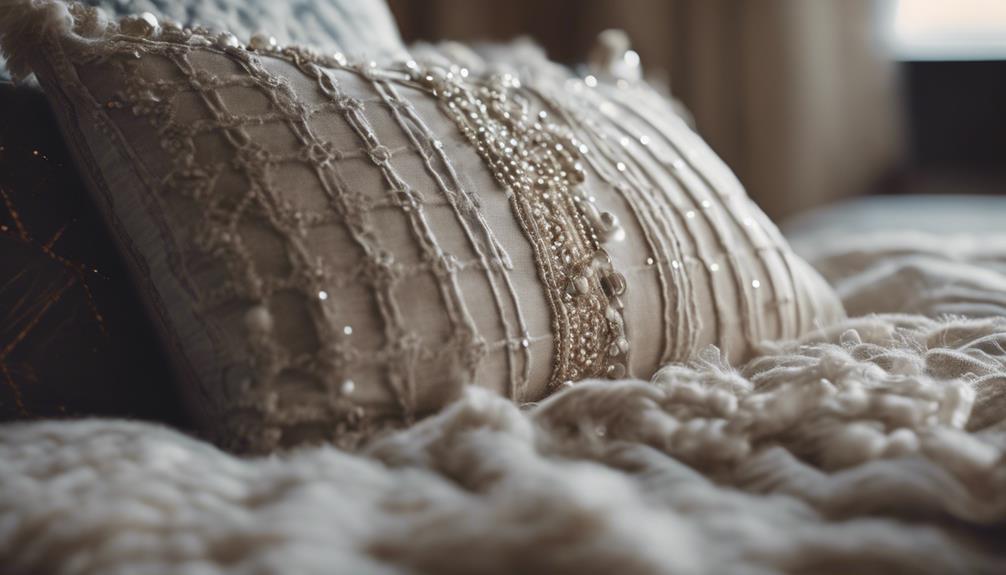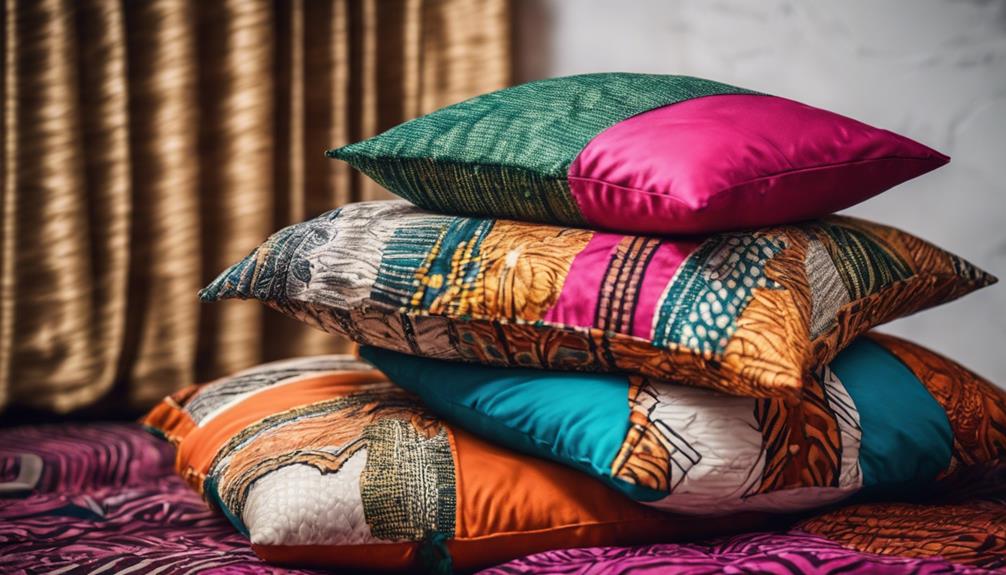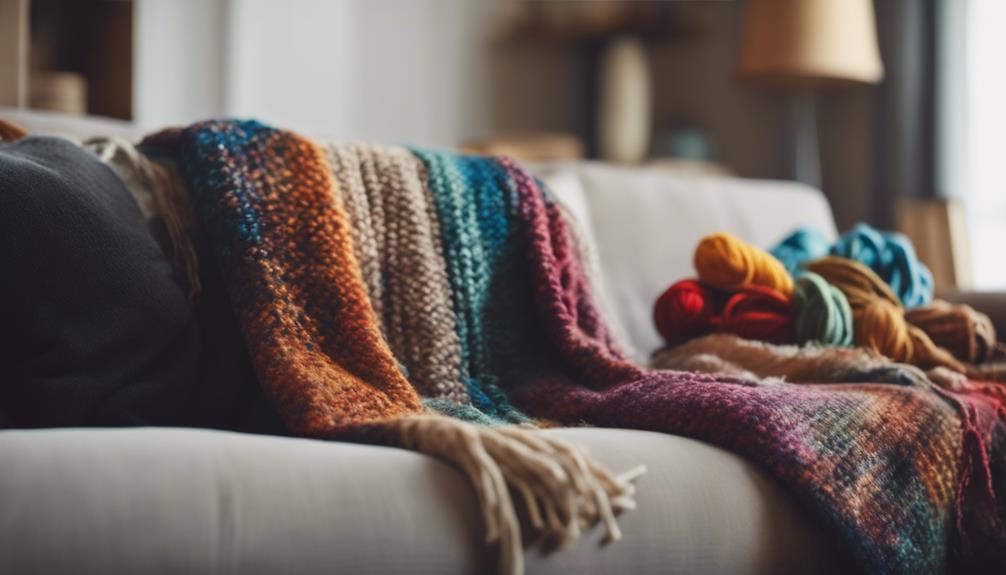Electric throws generally use about 200 watts per hour, which makes them a moderate electricity consumer. Running it for 10 hours could cost between 15 to 30 cents. By adjusting the heat settings and being mindful of how long you use it, you can effectively manage electricity costs. Other factors, such as energy-efficient models with auto shut-off features and localized warmth, make electric throws a cozy and cost-effective heating solution. Further insights on how to optimize usage and reduce expenses can be found here.
Key Takeaways
- Electric throws typically consume 200 watts per hour.
- Using it for 10 hours may cost 15 to 30 cents.
- Lower heat settings reduce overall electricity usage.
- Energy-efficient models with auto shut-off save energy.
- Monitoring usage patterns optimizes efficiency.
Electric Throw Electricity Consumption
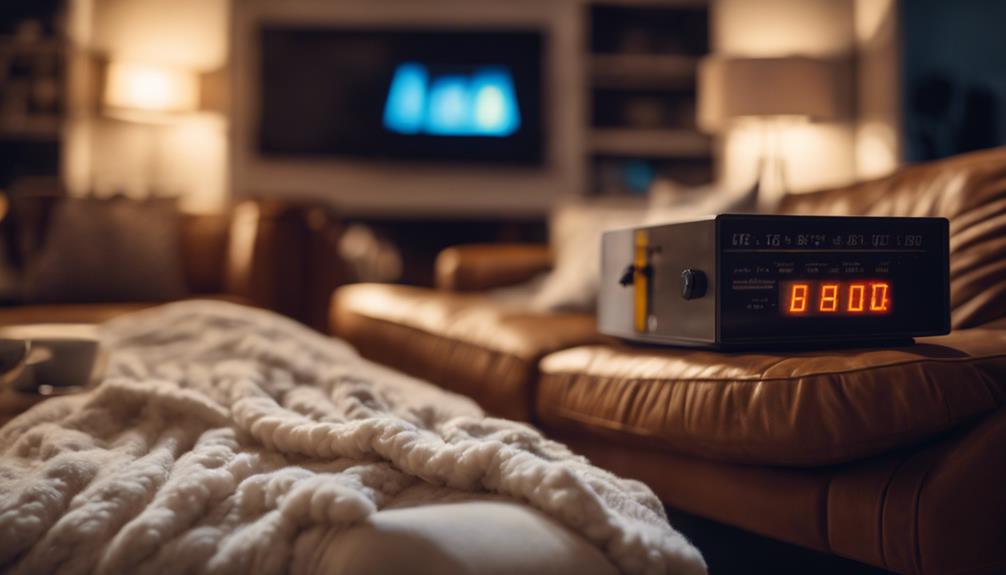
When utilizing an electric throw, it's important to be aware that we typically consume around 200 watts of power per hour. This electricity usage may not seem like much, but it can accumulate over time.
For instance, using an electric throw for 10 hours could cost anywhere between 15 to 30 cents, depending on your electricity rates. To manage the cost of energy consumption, it's crucial to monitor how long you use the electric throw and consider the wattage.
Some electric throws come with different heat settings, which can impact their energy usage. Time of use plans can also play a role in determining the overall electricity costs of using an electric throw. By being mindful of how much electricity your electric throw is using, you can better control the costs associated with its usage.
Factors Affecting Electric Throw Usage

When considering electric throw usage, factors such as power consumption comparison, heating settings impact, and energy-saving features play an important role in determining electricity usage.
Understanding how different wattages affect energy consumption, adjusting heat settings for efficiency, and utilizing energy-efficient technologies like Intelliheat+ can help optimize electric throw usage.
Power Consumption Comparison
Comparing power consumption among electric throws involves evaluating factors such as wattage, duration of use, and heat settings to gauge their electricity usage efficiency. Electric throws typically consume around 200 watts of power, which is relatively low in comparison to other heating devices.
Factors like the wattage of the throw, how long it's used, and the heat settings all play a role in electricity consumption. Opting for energy-efficient models with features like auto shut-off and adjustable heat settings can help lower electricity usage.
To further reduce energy consumption, consider using the electric throw for shorter periods or pre-warming it on a lower setting. By monitoring and optimizing the usage patterns of your electric throw, you can effectively manage and cut down on electricity costs.
Heating Settings Impact
The impact of heating settings on electric throw usage can greatly influence electricity consumption. When using an electric blanket, the heating setting chosen directly affects the amount of electricity consumed. Higher heat settings draw more power, leading to increased energy usage.
Opting for a lower heat setting can help in reducing overall electricity consumption while still providing warmth and comfort. Models with adjustable heat settings offer the flexibility to manage electricity usage effectively. By monitoring and adjusting the heat settings based on personal comfort needs, individuals can have a significant impact on the electricity usage of their electric throw.
Choosing the appropriate heating setting is key in balancing comfort with energy efficiency when using an electric blanket.
Energy-Saving Features
Energy-saving features incorporated into electric throws play an important role in reducing electricity consumption. By utilizing features like auto shut-off and timer settings, users can control usage and save energy, ultimately leading to lower power bills. Efficient insulation in high-quality electric throws helps retain heat longer, reducing the need for continuous usage. Opting for lower wattage options also contributes to saving energy while still providing warmth. Additionally, using electric throws on lower heat settings or pre-warming them can further help in conserving energy. These energy-saving measures not only benefit the environment but also help consumers manage their electricity usage effectively.
| Energy-Saving Feature | Description | Benefit |
|---|---|---|
| Auto Shut-Off | Automatically turns off after a set time | Prevents energy wastage |
| Timer Settings | Allows users to control usage | Efficient energy management |
| Efficient Insulation | Retains heat longer | Reduces need for continuous use |
| Lower Wattage Options | Consumes less electricity | Saves energy consumption |
Impact on Daily Energy Consumption

When utilizing an electric throw, it's essential to consider its impact on daily energy consumption, particularly because of its typical power usage of around 200 watts per hour. Compared to other electric blankets, heated throws can be more energy-efficient due to their localized warmth provision.
For instance, using an electric throw for 10 hours daily may only cost between 15 to 30 cents in electricity, depending on your local rates. However, it's important to note that energy consumption can vary based on the wattage of the electric throw and individual usage habits.
To optimize energy efficiency, monitoring your usage patterns and adjusting settings accordingly can help reduce overall electricity usage. By being mindful of how long you use the electric throw and at what settings, it's possible to manage daily energy consumption effectively while still enjoying the warmth and comfort it provides.
Strategies to Manage Electricity Usage
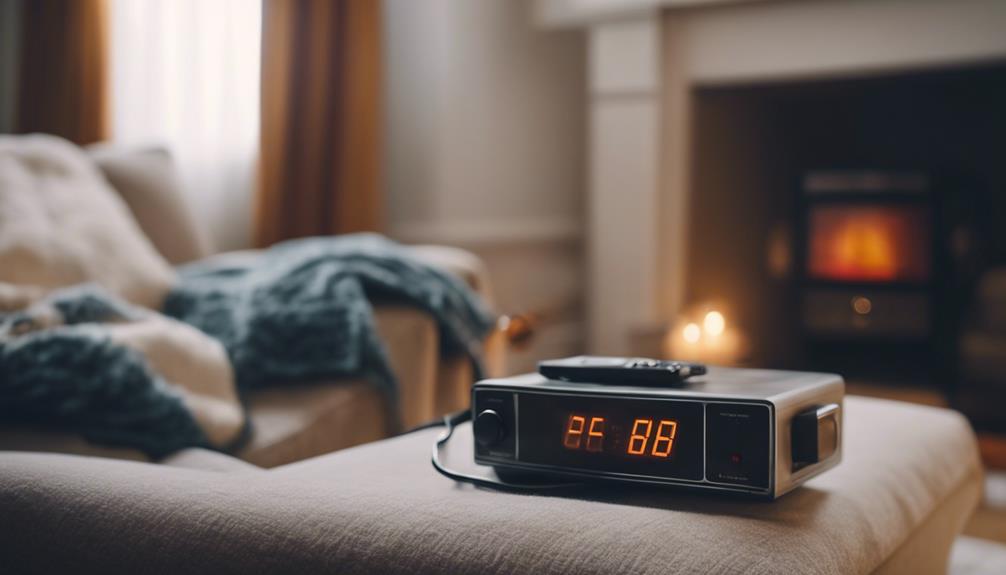
To effectively manage electricity usage with an electric throw, we must adopt energy-saving tips, utilize usage monitoring tools, and implement efficient heating methods.
By adjusting settings, pre-warming, and optimizing insulation, we can maximize the throw's efficiency while minimizing energy consumption.
These strategies not only lower electricity bills but also contribute to a more sustainable and environmentally-friendly approach to heating our homes.
Energy-Saving Tips
Implementing simple adjustments can effectively reduce electricity usage while using an electric throw. For instance, lowering the thermostat and pre-warming the blanket on a low setting are practical steps. Lowering the thermostat by just 1 degree can save up to 10% on energy bills. Using a heated throw on a low setting to pre-warm the blanket before use can also help cut down on energy consumption.
Closing doors in unused rooms can conserve heat and contribute to lower electricity usage. Investing in home energy-efficient solutions like draught excluders, thicker curtains, and radiator shelves can complement the energy-saving benefits of using an electric throw.
Turning down central heating and relying on a heated throw or blanket can be a cost-effective way to manage electricity consumption during colder months.
Usage Monitoring Tools
Monitoring tools provide valuable insights into managing electricity usage efficiently, allowing users to track and optimize energy consumption effectively. By utilizing plug-in power monitors or energy-saving power meters, individuals can gain real-time data on how much electricity appliances like electric blankets consume. Testing different appliances with varying wattages aids in understanding their impact on overall energy usage. Smart meters offer a convenient way to monitor and manage electricity consumption, including that of electric throws. These tools can help identify high-energy-consuming appliances and optimize energy efficiency in the home.
| Plug-in Power Monitors | Energy-Saving Power Meters | Smart Meters |
|---|---|---|
| Real-time data tracking | Insights into electricity usage | Convenient monitoring |
Efficient Heating Methods
Efficient heating methods can greatly impact electricity usage, offering cost-effective strategies to manage energy consumption. Lowering the thermostat by just 1 degree can save up to 10% on your energy bill, making it a practical way to reduce electricity consumption.
Pre-warming an electric blanket on a low setting before use can help save energy by decreasing the time it needs to run at higher temperatures. Utilizing energy-efficient house insulation can lower the heat setting required for the electric blanket, which contributes to reduced electricity usage.
Keeping doors shut in unused rooms and using draught excluders can help retain heat, reducing the reliance on the electric blanket for warmth. Monitoring usage patterns and wattage of the electric blanket can provide insights on optimizing its use for efficient heating while managing electricity consumption.
Comparing Electric Throw With Other Appliances
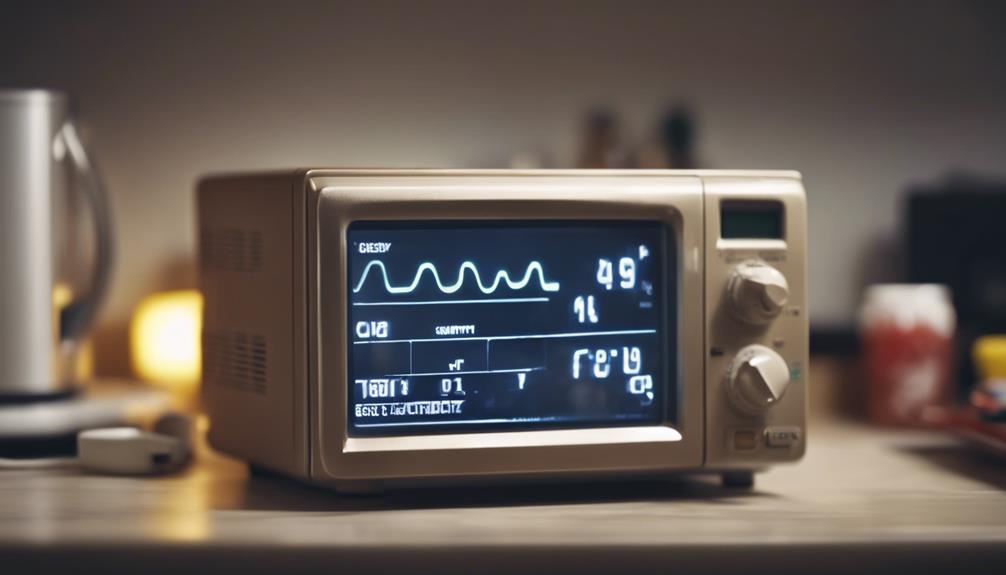
When considering the energy consumption of an electric throw in comparison to other appliances, it becomes evident that its power usage aligns closely with that of common devices like laptops or desktop computers. An electric throw typically consumes around 200 watts of power, costing between 15-30 cents for 10 hours of use, depending on electricity rates.
When it comes to energy consumption, using an electric throw is more cost-effective than running a hair dryer for the same duration. These electric blankets are designed to offer localized warmth, making them efficient for heating individuals rather than entire rooms.
Compared to running a space heater, using an electric throw can lead to lower electricity bills due to its focused heating capabilities. Understanding the energy efficiency and cost-effectiveness of electric throws compared to other appliances can help in making informed decisions when it comes to heating solutions in your home.
Optimizing Home Heating Systems

To enhance the efficiency of home heating systems, understanding the energy consumption of electric throws can be a practical starting point. Electric throws typically use 100-150 watts of power, making them energy-efficient heating options.
Running an electric blanket for 10 hours a day at 150 watts can cost around 15-22.5 cents daily.
Modern electric throws offer adjustable settings for personalized comfort and energy savings. They provide localized warmth, allowing you to lower the overall thermostat setting and reduce heating costs.
By monitoring your usage patterns and optimizing the settings on your heating unit, you can decrease electricity consumption while staying cozy with an electric throw. Making small adjustments can lead to significant savings in the long run.
Exploring Energy-Efficient Alternatives
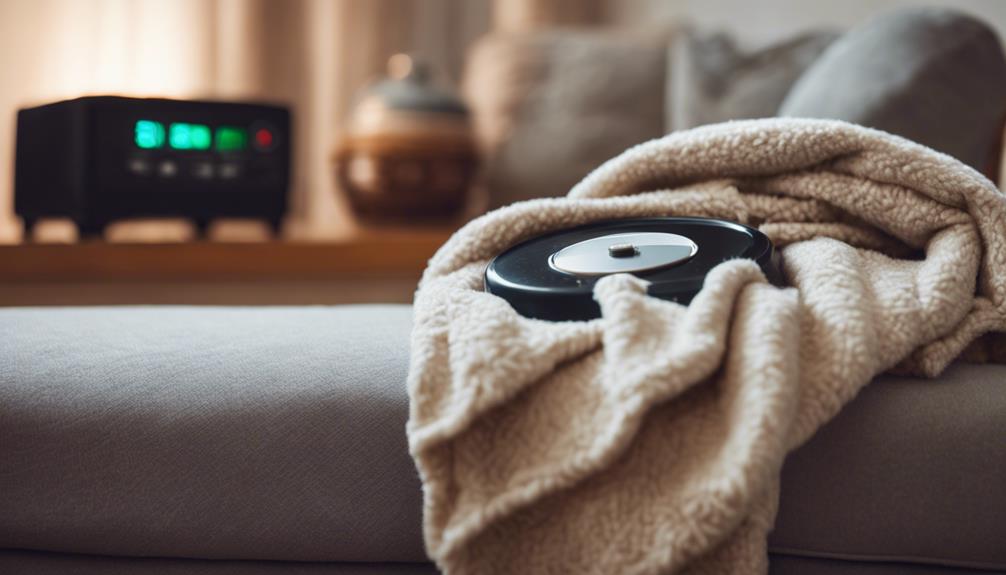
Exploring energy-saving options beyond electric throws, such as utilizing thick blankets or duvets, presents practical alternatives for maintaining warmth in a cost-effective manner. By making small adjustments and incorporating energy-efficient alternatives, you can reduce your reliance on electric blankets and save on electricity costs. Here are some effective strategies to contemplate:
| Energy-Efficient Alternatives | Benefits |
|---|---|
| Thick Blankets or Duvets | Provide warmth without the need for electricity |
| Draft Excluders & Thermal Curtains | Retain heat in the room, reducing the need for electric throws |
| Radiator Shelves | Direct heat effectively, decreasing reliance on electric blankets |
These options not only help in conserving energy but also contribute to a more sustainable and cost-effective approach to staying warm. By integrating these energy-efficient alternatives into your daily routine, you can create a cozy environment while minimizing the use of electric throws.
Monitoring Energy Consumption Patterns
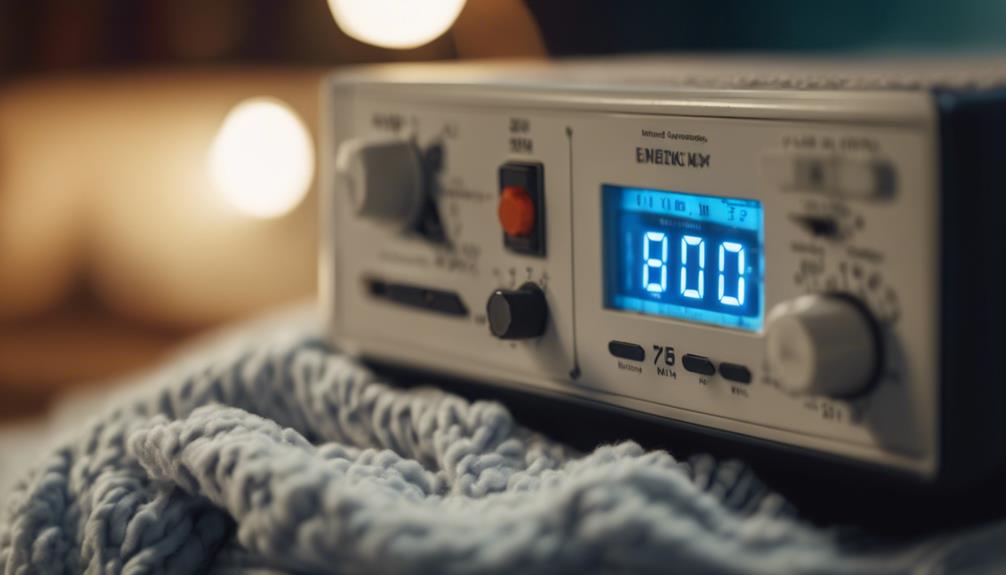
Monitoring energy consumption patterns involves actively tracking the wattage and duration of electric throw usage. By understanding variations in heating settings and their impact on energy consumption, one can effectively monitor the electricity usage of heated blankets. Factors like illness affecting usage patterns should also be considered when analyzing energy consumption with a heated blanket.
Running an electric throw for an hour typically costs about 2.2p, equivalent to the consumption of a fridge-freezer and another appliance. Analyzing overall energy consumption with an electric throw is significant for evaluating its efficiency and cost-effectiveness. By keeping a close eye on the wattage and duration of usage, one can make informed decisions to balance comfort and cost-effectiveness effectively.
This monitoring process provides valuable insights into energy consumption patterns, enabling users to optimize their use of electric blankets while keeping electricity costs in check.
Balancing Comfort and Cost-effectiveness
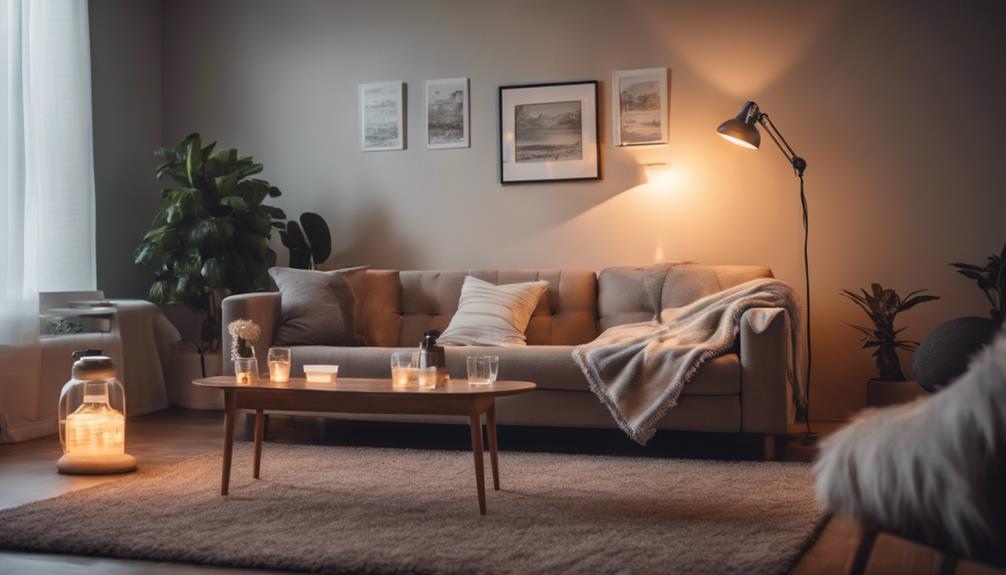
Achieving a balance between comfort and cost-effectiveness when using an electric throw requires careful consideration of energy consumption patterns and heating preferences. Electric blankets typically consume around 200 watts of power, making them relatively energy-efficient. The cost of using an electric throw for 10 hours ranges between 15-30 cents, depending on your electricity rate.
Energy consumption can vary based on the wattage of the electric throw and how long it's used. To stay warm during colder months in a cost-effective way, consider lowering the thermostat and using an electric throw. Monitoring your energy consumption with an electric throw can help you strike a balance between comfort and cost-effectiveness.
Frequently Asked Questions
Do Electric Blankets Raise Your Electric Bill?
Electric blankets typically add only around 1.37% to your annual electricity bill, consuming 100-150 watts of power. Using one for 6 hours nightly for 4 months can total about 108 kWh/year.
The cost is relatively low compared to other appliances, so efficient use can help save on electricity costs. Overall, while they use electricity, they won't drastically increase your bill when used responsibly.
Are Electric Throws Expensive to Run?
Electric throws, on average, consume around 200 watts of power. Running one for 10 hours typically costs between 15-30 cents. The energy usage may vary based on the throw's wattage.
To keep electricity costs low, we recommend using electric throws efficiently. Monitoring usage patterns and adjusting settings can help optimize energy consumption.
Are Electric Blankets Heavy on Electricity?
Electric throws aren't heavy on electricity usage. They typically consume around 200 watts, costing 15-30 cents for 10 hours. Compared to other heating options, they're energy-efficient and can help save on bills.
Measuring consumption with an electric meter is easy. Adhering to safety guidelines and using them efficiently can keep costs low and guarantee safe usage.
How Much Does It Cost to Have an Electric Blanket on for 1 Hour?
When an electric blanket is used for an hour, the cost typically ranges from 1-10 cents, depending on the wattage. Lower wattage models can be more energy-efficient, costing around 1-3 cents per hour.
To save more, adjusting the heat setting and using the blanket for shorter periods helps cut down on electricity use.
Are Electric Throws Energy Efficient?
Yes, electric throws are energy efficient. When considering electric throw electricity usage, these devices are designed to provide warmth while using minimal electricity. They offer a cost-effective and eco-friendly alternative to traditional heating methods, making them an efficient choice for staying warm without excessive energy consumption.
Conclusion
To sum up, while an electric throw does use electricity, it's relatively energy-efficient compared to other heating appliances. By implementing strategies to manage electricity usage and exploring energy-efficient alternatives, you can balance comfort with cost-effectiveness.
Remember to monitor your energy consumption patterns and optimize your home heating systems to guarantee a cozy and efficient living space. With a little effort, you can stay warm without breaking the bank.



